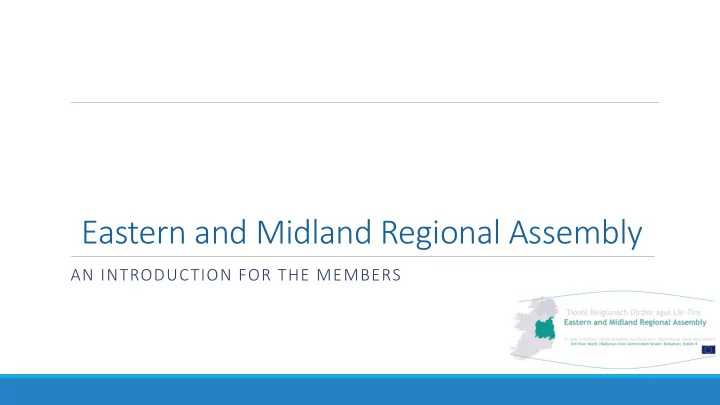

Eastern and Midland Regional Assembly AN INTRODUCTION FOR THE MEMBERS
Content of presentation Context of Regional Reform Local Government Act 2014 Regional Elements Implementation of Regional Re-organisation Establishing the Assemblies Principal Functions of Regional Assemblies Challenges and Opportunities
Context Local Government Reform Act 2014 introduced new political and administrative structures in local government nationally. The two main objectives of the Act were to provide for the significant reorganisation of local government structures and the strengthening of governance and accountability in local government. An emphasis on more effective use of scarce resources, avoidance of duplication. Political reform. Addressing certain planning matters.
Local Government Reform Act 2014 Regional elements Rationalise regional structures/bodies. Reduce number of Regional Authorities/Assemblies. Reconfigure geography of regions. Establish relationship with National Oversight and Audit Commission. Combine regional spatial planning with a new regional economic planning function, and with European Regional Policy.
Local Government Reform Act 2014 Regional elements Dissolve the 8 Regional Authorities and 2 Regional Assemblies Reconfigure into 3 Regional Assemblies Transfer the existing Regional Planning functions from the former Regional Authorities to the new Regional Assemblies Enhance and strengthen the regional planning function by integrating it with economic planning Reduce the number of Members of Assemblies to be nominated by the constituent Local Authorities Develop the links between the Committee of Regions and Regional Assemblies.
Establishing the Assemblies Because the geography of new regions was under consideration the reorganisation proposals had to be conducted in two phases: Phase 1 – 1 st June 2014 dissolution of regional authorities and transfer of their assets, liabilities and staff to two existing Regional Assemblies. Also transfer of their functions relating to Regional Planning Guidelines. All of this undertaken by way of Statutory Instrument (S.I. No 228 of 2014)
Establishing the Assemblies Phase 2 – dissolution of two existing regional assemblies and the establishment of three new Assemblies: Eastern and Midlands Northern and Western Southern This took effect on the 1 st January 2015 in accordance with the provisions of Establishment Order SI 573 of 2014.
Establishing the Assemblies New office located in Ballymun Civic Centre Establishing Structures Establishing process of engagement with EU Operational Programmes and Programme Monitoring Committees Initiating stakeholder engagements Recruitment of staff
Establishing the Assemblies
Principal functions of Regional Assemblies SI 573 of 2015 sets out the principal functions of the Assemblies as follows: To co-ordinate, promote or support strategic planning and sustainable development of the regions To promote effectiveness in local government and public services in the region, in conjunction with the National Oversight & Audit Commission To manage Regional Operational Programmes under the Partnership Agreement as well as monitoring and making proposals in relation to the general impact in their regions of all EU programmes of assistance from the EU. To prepare and oversee the implementation of the Regional Planning Guidelines, to be replaced by new Regional Spatial and Economic Strategies, and providing statutory observations on local authority development plans and variations.
Challenges Logistical – new organisations, new members, new regions, etc. Resource – both financial and human Procedural – new procedures to be followed, new structures to be put in place Political – new elected members, relationships with central government and other bodies Functional – Regional Spatial and Economic Strategies, Local Economic Community Plans, NOAC Statistical – miss-match between new Assembly Regions & NUTS Classification
Challenges External challenges – engagement with statutory bodies, central government and local government. New National Planning Framework to be developed. Preparation of RSES must be a collaborative production between Assemblies, Local Authorities and key stakeholders, with implementation monitoring and delivery Internal challenges – ensuring that teams are put in place within Regional Assemblies to deliver on the new mandate.
Challenges Ensuring RSES and LECP processes add value to overall system Achieving the correct balance between National, NUTS II and NUTS III and LA area economic planning. Addressing any disparities in economic performance – how to co-ordinate Government, regional and local levels? Promoting ‘regional’ thinking within central Government and national agencies
Opportunities There are many new opportunities arising from the regional reform process. Some of the more significant opportunities would include: Building on the existing strengths of the Region, rural and urban Establish adequately resourced and staffed regional bodies to deliver on the new significant roles and responsibilities provided by legislation. Further developing regional input into policy formulation Achieving increased regional differentiation in policy delivery
Opportunities Ensuring that designated growth centres continue to develop as effective drivers of the regional economy. Building on the success of the RPGs to achieve regional economic development and investment strategies. Effective implementation of Regional Planning Guidelines/RSES in the context of anticipated resumption of economic activity. Enhancing regional capacity to identify, evaluate, prioritise and promote successful regional development initiatives and become more effective policy influencers.
For further discussion Members training / orientation Regional topics for future meetings Presentations Briefings / Updates Finally……
End Jim Conway Eastern and Midland Regional Assembly 3 rd Floor North, Ballymun Civic Centre, Ballymun Dublin 9 E mail jconway@emra.ie Web emra.ie
Recommend
More recommend